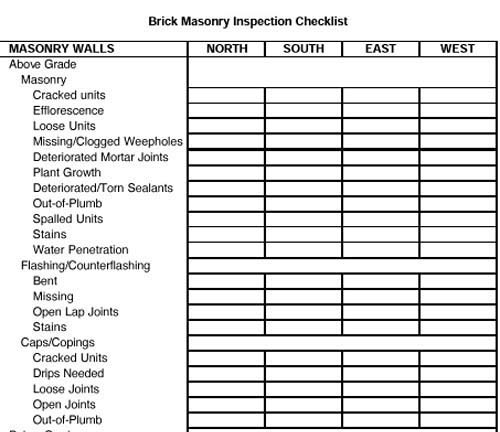Maintenance
GENERAL INSPECTION
A good, thorough inspection and maintenance program is often inexpensive to initiate and may prove advantageous in extending the life of a building. It is a good idea to become familiar with the materials used on a building and how they perform over a given time period.
It is suggested that periodic inspections be performed to determine the condition of the various materials used on a building. These inspections can be set for any given time period, i.e., weekly, monthly, yearly, etc. A suggested inspection period is “seasonal” so that the behavior of building materials in various weather conditions can be noted. Inspection records, including conditions and comments, should be kept to determine future “trouble spots”, problems and needed repair.
SPECIFIC MAINTENANCE
Problems resulting from moisture penetration may include: efflorescence, spalling, deteriorating mortar joints, interior moisture damage, etc. Once one or more of these conditions becomes evident, the direct source of moisture penetration should be determined and action taken to correct both the visible effect and the moisture penetration source. Table 3 lists various problems appearing on brickwork due to moisture and the most probable source of moisture penetration. The items checked in the table represent each source that should be considered when such problems occur in brick masonry.
After investigating all of the possible moisture penetration sources, the actual source may be determined through the process of elimination. Many times the source will be self-evident as in the cases of deteriorated and missing materials; however, in instances such as improper flashing, differential movement, etc., the source may be hidden and determined only through some type of building diagnostics. In any case, it is suggested to first visually inspect for the self-evident source before retaining a consultant as it may save time and money in the detection of the moisture penetration source.
Once the source is determined, measures can then be taken to effectively remedy the moisture penetration source and its effects on the brickwork.

Table 1 Checklist
References
1. “A Glossary of Historic Masonry Deterioration Problems and Preservation Treatments”, Anne E. Grimmer, Department of the Interior, National Park Service, Preservation Assistance Division, Washington, D.C., 1984.
2. “Basic Masonry Techniques”, March 1985.
3. “Building Materials and Structures”, BMS 33, ‘Plastic Caulking Materials’, National Bureau of Standards, U.S. Department of Commerce, Washington, D.C., 1940.
4. “Building Materials and Structures”, BMS 63, ‘Moisture Condensation in Building Walls’, National Bureau of Standards, U.S. Department of Commerce, Washington, D.C., 1940.
5. “Building Materials and Structures”, BMS 76, ‘Effect of Outdoor Exposure of the Water Permeability on Masonry Walls’, National Bureau of Standards, U.S. Department of Commerce, Washington, D.C., 1941.
6. “Building Materials and Structures”, BMS 94, ‘Water Permeability and Weathering Resistance of Stucco-Faced, Gunite-Faced and “Knap Concrete Unit” Walls’, National Bureau of Standards, U.S. Department of Commerce, Washington. D.C.. 1942.
7. “Building Materials and Structures”, BMS 95, ‘Tests of Cement-Water Paints and Other Waterproofings for Unit-Masonry Walls’, National Bureau of Standards, U.S. Department of Commerce, Washington, D.C., 1943.
8. “Maintenance Engineering Handbook”, 3rd Edition, Higgins, L.R. and Morrow, L.C., McGraw-Hill Publishing Company, 1977.
9. “Paints for Exterior Masonry Walls”, Building Materials and Structures Report BMS 110, National Bureau of Standards, U.S. Department of Commerce, Washington, D.C., 1947.
10. “Cleaning of Clay Masonry”, Soderstrom, W.K., Structural Clay Products Research Foundation, May 1964.
11. ENGINEERING AND RESEARCH DIGEST, “Ivy on Brick (Pro and Con)”, Brick Institute of America, McLean, Virginia, May 1980.
12. ENGINEERING AND RESEARCH DIGEST, “Tuck-Pointing”, Brick Institute of America, McLean, Virginia, 1983.
13. Old House Journal, No. 5, Vol. XIII, Brooklyn, New York, June 1985.
14. “Penetrative Stains for Masonry”, Hoskins, R.A., Hodsons Dye Agency P/L.
15. Preservation Briefs No. 2, “Repointing Mortar Joints in Historic Brick Buildings”, Heritage, Conservation and Recreation Service, U.S. Department of the Interior, Washington, D.C., 1980.
16. Research Report 15, “The Causes and Control of Efflorescence on Brickwork”, Wayne E. Brownell, Structural Clay Products Institute, August 1969.